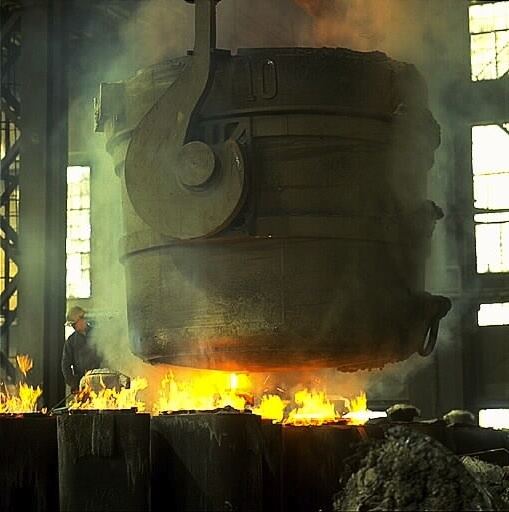 | ||
Carbon steel is steel in which the main interstitial alloying constituent is carbon in the range of 0.12–2.0%. The American Iron and Steel Institute (AISI) definition says:
Contents
- Mild and low carbon steel
- Higher carbon steels
- Types
- Low carbon steel
- Medium carbon steel
- High carbon steel
- Ultra high carbon steel
- Heat treatment
- Case hardening
- References
The term "carbon steel" may also be used in reference to steel which is not stainless steel; in this use carbon steel may include alloy steels.
As the carbon percentage content rises, steel has the ability to become harder and stronger through heat treating; however, it becomes less ductile. Regardless of the heat treatment, a higher carbon content reduces weldability. In carbon steels, the higher carbon content lowers the melting point.
Mild and low-carbon steel
Mild steel (steel containing a small percentage of carbon, strong and tough but not readily tempered), also known as plain-carbon steel, is now the most common form of steel because its price is relatively low while it provides material properties that are acceptable for many applications. Low-carbon steel contains approximately 0.05–0.25% carbon making it malleable and ductile. Mild steel has a relatively low tensile strength, but it is cheap and easy to form; surface hardness can be increased through carburizing.
It is often used when large quantities of steel are needed, for example as structural steel. The density of mild steel is approximately 7.85 g/cm3 (7850 kg/m3 or 0.284 lb/in3) and the Young's modulus is 200 GPa (29,000,000 psi).
Low-carbon steels suffer from yield-point runout where the material has two yield points. The first yield point (or upper yield point) is higher than the second and the yield drops dramatically after the upper yield point. If a low-carbon steel is only stressed to some point between the upper and lower yield point then the surface develop Lüder bands. Low-carbon steels contain less carbon than other steels and are easier to cold-form, making them easier to handle.
Higher-carbon steels
Carbon steels which can successfully undergo heat-treatment have a carbon content in the range of 0.30–1.70% by weight. Trace impurities of various other elements can have a significant effect on the quality of the resulting steel. Trace amounts of sulfur in particular make the steel red-short, that is, brittle and crumbly at working temperatures. Low-alloy carbon steel, such as A36 grade, contains about 0.05% sulfur and melts around 1,426–1,538 °C (2,599–2,800 °F). Manganese is often added to improve the hardenability of low-carbon steels. These additions turn the material into a low-alloy steel by some definitions, but AISI's definition of carbon steel allows up to 1.65% manganese by weight.
Types
Carbon steel is broken down into four classes based on carbon content:
Low-carbon steel
0.05 to 0.25% carbon content.
Medium-carbon steel
Approximately 0.3–0.6% carbon content. Balances ductility and strength and has good wear resistance; used for large parts, forging and automotive components.
High-carbon steel
Approximately 0.6–1.0% carbon content. Very strong, used for springs, swords, and high-strength wires.
Ultra-high-carbon steel
Approximately 1.25–2.0% carbon content. Steels that can be tempered to great hardness. Used for special purposes like (non-industrial-purpose) knives, axles or punches. Most steels with more than 2.5% carbon content are made using powder metallurgy.
Heat treatment
The purpose of heat treating carbon steel is to change the mechanical properties of steel, usually ductility, hardness, yield strength, or impact resistance. Note that the electrical and thermal conductivity are only slightly altered. As with most strengthening techniques for steel, Young's modulus (elasticity) is unaffected. All treatments of steel trade ductility for increased strength and vice versa. Iron has a higher solubility for carbon in the austenite phase; therefore all heat treatments, except spheroidizing and process annealing, start by heating the steel to a temperature at which the austenitic phase can exist. The steel is then quenched (heat drawn out) at a moderate to low rate allowing carbon to diffuse out of the austenite forming iron-carbide (cementite) to precipitate leaving ferrite, or at a high rate, trapping the carbon within the iron thus forming martensite. The rate at which the steel is cooled through the eutectoid temperature (about 727°C) affects the rate at which carbon diffuses out of austenite and forms cementite. Generally speaking, cooling swiftly will leave iron carbide finely dispersed and produce a fine grained pearlite and cooling slowly will give a coarser pearlite. Cooling a hypoeutectoid steel (less than 0.77 wt% C) results in a lamellar-pearlitic structure of iron carbide layers with α-ferrite (nearly pure iron) between. If it is hypereutectoid steel (more than 0.77 wt% C) then the structure is full pearlite with small grains (larger than the pearlite lamella) of cementite formed on the grain boundaries. A euctoid steel (0.77% carbon) will have a pearlite structure throughout the grains with no cementite at the boundaries. The relative amounts of constituents are found using the lever rule. The following is a list of the types of heat treatments possible:
Case hardening
Case hardening processes harden only the exterior of the steel part, creating a hard, wear resistant skin (the "case") but preserving a tough and ductile interior. Carbon steels are not very hardenable meaning they can not be hardened throughout thick sections. Alloy steels have a better hardenability, so they can through-hardened and do not require case hardening. This property of carbon steel can be beneficial, because it gives the surface good wear characteristics but leaves the core tough.
